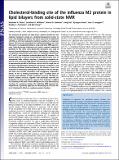Cholesterol-binding site of the influenza M2 protein in lipid bilayers from solid-state NMR
Author(s)
Sergeyev, Ivan V.; Hong, Mei; Elkins, Matthew Ryan; Williams, Jonathan Kyle; Gelenter, Martin David; Dai, Peng; Kwon, Byungsu; Pentelute, Bradley L.; ... Show more Show less
Download12946.full.pdf (1.380Mb)
PUBLISHER_POLICY
Publisher Policy
Article is made available in accordance with the publisher's policy and may be subject to US copyright law. Please refer to the publisher's site for terms of use.
Terms of use
Metadata
Show full item recordAbstract
The influenza M2 protein not only forms a proton channel but also mediates membrane scission in a cholesterol-dependent manner to cause virus budding and release. The atomic interaction of cholesterol with M2, as with most eukaryotic membrane proteins, has long been elusive. We have now determined the cholesterol-binding site of the M2 protein in phospholipid bilayers using solid-state NMR spectroscopy. Chain-fluorinated cholesterol was used to measure cholesterol proximity to M2 while sterol-deuterated cholesterol was used to measure bound-cholesterol orientation in lipid bilayers. Carbon–fluorine distance measurements show that at a cholesterol concentration of 17 mol%, two cholesterol molecules bind each M2 tetramer. Cholesterol binds the C-terminal transmembrane (TM) residues, near an amphipathic helix, without requiring a cholesterol recognition sequence motif. Deuterium NMR spectra indicate that bound cholesterol is approximately parallel to the bilayer normal, with the rough face of the sterol rings apposed to methyl-rich TM residues. The distance- and orientation-restrained cholesterol-binding site structure shows that cholesterol is stabilized by hydrophobic interactions with the TM helix and polar and aromatic interactions with neighboring amphipathic helices. At the 1:2 binding stoichiometry, lipid31P spectra show an isotropic peak indicative of high membrane curvature. This M2–cholesterol complex structure, together with previously observed M2 localization at phase boundaries, suggests that cholesterol mediates M2 clustering to the neck of the budding virus to cause the necessary curvature for membrane scission. The solid-state NMR approach developed here is generally applicable for elucidating the structural basis of cholesterol’s effects on membrane protein function. Keywords: membrane; ¹⁹F-NMR; deuterium NMR; docking; membrane scission
Date issued
2017-11Department
Massachusetts Institute of Technology. Department of ChemistryJournal
Proceedings of the National Academy of Sciences
Publisher
National Academy of Sciences (U.S.)
Citation
Elkins, Matthew R. et al. “Cholesterol-Binding Site of the Influenza M2 Protein in Lipid Bilayers from Solid-State NMR.” Proceedings of the National Academy of Sciences 114, 49 (November 2017): 12946–12951 © 2017 National Academy of Sciences
Version: Final published version
ISSN
0027-8424
1091-6490